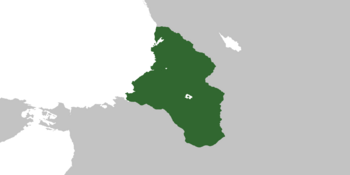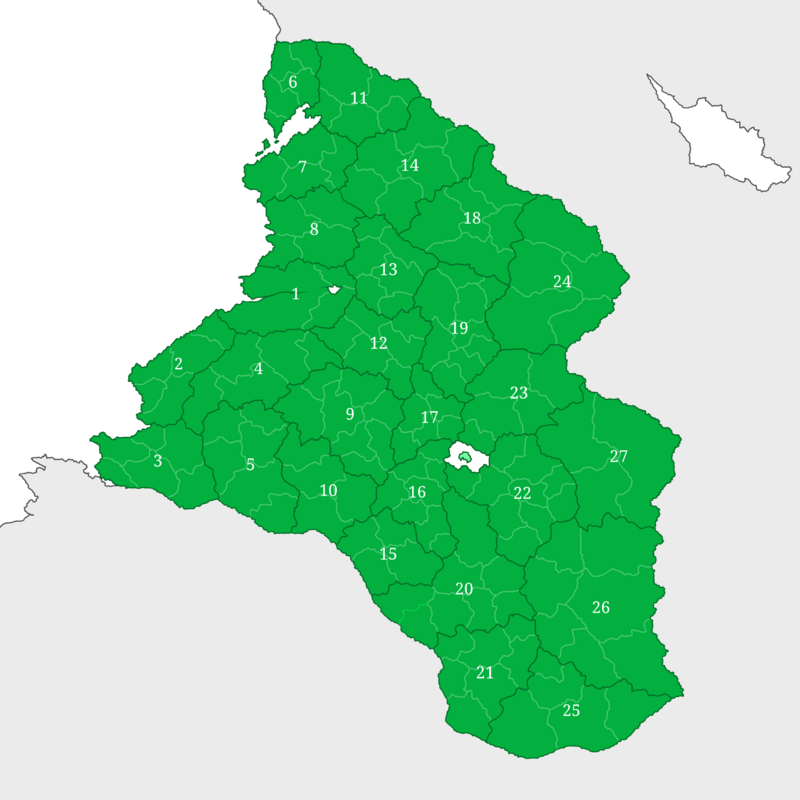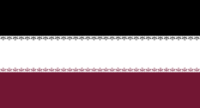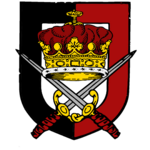Khijovia: Difference between revisions
No edit summary |
No edit summary |
||
| Line 8: | Line 8: | ||
| alt_flag = | | alt_flag = | ||
| image_coat = [[File:CoatOfArms.png|150px]] | | image_coat = [[File:CoatOfArms.png|150px]] | ||
| national_motto = <br/>Œþ øna | | national_motto = <br/>Œþ øna Đraconıæ nıəva Aþtọnŏė voera<br/>{{small|"''Love of the Motherland is our only Law''"}} | ||
| national_anthem = <br> Vara | | national_anthem = <br> Vara Khijovıænnĕ Ġanþŏra <br/>{{small|''The Glorious Khijovian Anthem''}}[[File:MediaPlayer.png|link=https://www.youtube.com/watch?v=UEI82RCaExw&ab_channel=Khijovia]] | ||
| royal_anthem = | | royal_anthem = | ||
| image_map = Khijovia.Map.png | | image_map = Khijovia.Map.png | ||
Revision as of 16:13, 22 September 2024
This article is incomplete because it is pending further input from participants, or it is a work-in-progress by one author. Please comment on this article's talk page to share your input, comments and questions. Note: To contribute to this article, you may need to seek help from the author(s) of this page. |
Ascended Kingdom of Khijovia Mœþra Khijovıænnĕ Krønıa | |
|---|---|
| Motto: Œþ øna Đraconıæ nıəva Aþtọnŏė voera "Love of the Motherland is our only Law" | |
| Anthem: Vara Khijovıænnĕ Ġanþŏra The Glorious Khijovian Anthem | |
 Lands and surroundings of the Ascended Kingdom of Khijovia, 1613 AR | |
| Capital and | Kleitore |
| Official languages | Khijovian |
| Ethnic groups | Humans (82.9%) Sheepfolk (8.6%) Goatfolk (6.4%) Kyleth (2.1%) |
| Religion | Aravianism (94.2%) Other (3.5%) Atheism (2.3%) |
| Demonym(s) | Khijovian |
| Government | Feudalistic Constitutional Monarchy |
• Ascended King of Khijovia | Arcadion II |
• Ascended Queen of Khijovia | Carevia I |
| Legislature | Royal Parliament |
| Establishment | |
• Foundation of the Ascended Kingdom | June 3, 1607 AR |
| Area | |
• Land Area | 1,386,546 km2 (535,348 sq mi) |
• Water (%) | 6.3 |
| Population | |
• 1613 AR estimate | 127,085,900 |
• Density | 86.6/km2 (224.3/sq mi) |
| GDP (nominal) | estimate |
• Total | $ 225,000,000,000.00 |
• Per capita | $ 1,772.00 |
| Currency | Shonenor (SHN) |
| Date format | dd/mm/yy |
| Driving side | right |
Khijovia (Khijovian: Khijovıæ [‘kɨjoːvjə]), officially the Ascended Kingdom of Khijovia, is an isolationist, semi-feudalistic constitutional monarchy situated in northwestern Pelia, with Kleitore serving as its capital. It shares its borders with Kyldigard to the north and Prestore to the south, while the Kesper Sea lies to the west. It occupies the northern portion of the High West region and possesses several overseas colonies, including the Recondian archipelago in the Wintry Ocean, Thenoria in northern Ilus, and Yvrethia in northeastern Pelia, which is the largest and most significant of these territories. Mainland Khijovia has an estimated population of approximately 110 million, making it the most populous country in Pelia. The colonial territories contribute an additional 17 million inhabitants, bringing the total population of Khijovia to 127 million. Known for its deeply spiritual society, the nation has maintained a unique connection with the magical arts throughout its history, with approximately 94% of the population belonging to the Aravian faith.
During ancient times, Khijovia served as a crossroads for numerous neolithic cultures. Thriving city-states emerged during the Era of Ruin, preserving their cultural identity and language staunchly against external influences. Notwithstanding the upheavals in the rest of Sparkalia, Khijovia remained isolated, relatively unaffected by wars and famines until the catastrophic Abheric Wars and the subsequent collapse of the city-state system around 277 BR, ushering in the Barren Age and marking the end of the Archaic Age in Khijovian history. Despite suffering continental amnesia during the Great Shuffle, Khijovian culture persisted. In 289 AR, the Kveutonian civilization conquered and divided Khijovia into governatorates, making it a crucial economic and cultural hub within the Kveutonian Empire. The empire reached its zenith around 415 but dissolved in 502, leading to the formation of independent statelets and religious-monastic military orders, including the influential Jovianic Order. Over the centuries, cities transformed into feudal lordships, giving rise to Khijovian principalities, duchies, counties, and marquisates. The Grand Duke of Klettoria, Zenon the Great, initiated a national unification campaign in 1152, defeating the rival House of Arenia and establishing the Kingdom of Khijovia on July 11, 1161. Despite centuries of rule, the Zenonian Dynasty faced a coup on January 28, 1534, leading to the formation of the relatively short-lived Khijovian Federation. In May 1607, Prince Arcadion of the House of Zenon reclaimed power and officially founded the Ascended Kingdom of Khijovia on June 3, 1607.
Etymology
The origin of the name Khijovia has long intrigued linguists and historians, prompting diverse reconstructions. While some theories delve into etymological roots, others are steeped in historical narratives, including the intriguing notion of an ancient pre-Shuffle king named Khjvonnə in popular traditions.
One prevalent theory suggests that the name stems from Khjyvi, an exoethnonym used by the Koritians for a tribe residing in the neighboring Aldoria region. Another hypothesis, not mutually exclusive, proposes that these people venerated a pagan deity, Khœva, making the name signify "inhabitants of the land of Khœva."
History
Primordial Aeon
Prehistory
Approximately 35,000 years ago, the Acreans, a nomadic civilization, were the first known inhabitants of Khijovia. Evidence from the Yllia archaeological site on the Pletorian coasts reveals complex burial practices and shamanic rituals. Despite the Neolithic agricultural revolution, the Acreatics relied on hunting and gathering until climatic changes around the twelfth millennium BR led them to migrate inland, transitioning to transhumant farming and eventually settled agriculture, marking the end of their nomadic lifestyle.
Protohistory
The shift to agriculture and livestock in Khijovia led to population growth and early housing settlements, transitioning from matriarchy to patriarchy for village defense. The Copper Age saw distinct cultures like Venatorian, Khantan, and Koritian, while the Bronze and Iron Ages introduced the Xomian and Kleitite cultures. By 1400 BR, villages grew into cities, fostering interdependence with rural areas and developing a social hierarchy, forming the basis for an aristocratic caste.
Era of Ruin
Archaic Age
During the Era of Ruin in Khijovia, urban centers developed into autonomous city-states, each adopting distinct forms of governance. Some embraced theocratic rule, where priests wielded political power as representatives of the gods. Others transitioned to monarchies, separating political authority from religious influence, while some followed a timocratic system led by aristocrats based on land ownership and military prowess. Over time, democracy began to emerge from aristocratic roots, gradually granting citizens equal rights and reshaping political dynamics through alliances to mitigate internal strife despite ongoing political tensions.
League Phase
Abheric Wars
Barren Age
Khijovic Middle Ages
Syhric Advent
Nova Antiquity
Kveutonian Age
Jovianic Domination
Modern Era
Surgence Epoch
Zenonian Age
Khijovian Renascence
Koronian Civil War
Contemporary Age
Federalist Parenthesis
Ascension Period
Geography
Physical Geography
Situated within the expansive geographical region known as the High West, the Khijovian landscape showcases diverse features, making it one of the most varied regions on the Pelian continent. Bordered by the Kyldigardian region to the north, Khijovia is geographically enclosed by the Clastoclite range to the east and the Stornic massif to the south.
The Khijovian terrain exhibits a broad spectrum of characteristics, with a prevalence of hilly areas compared to flat or mountainous zones, maintaining an average altitude of approximately 730 meters above sea level. The mountainous landscapes extend across the eastern expanse of the nation, encompassing a significant portion of the western Clastoclite system. The highest peaks in Khijovia are situated in the central Clastoclites, where numerous summits exceed 5000 meters, including the remarkable Mount Eletherium (5800 meters), standing as the loftiest peak in the Clastoclite range. Over time, the Khijovian mountainous region has been shaped by an ancient Cenozoic glacial mass, leaving behind extensive moraines flanking the western Clastoclite slope, forming expansive highlands in the north and numerous shallow valleys amidst the southern hills.
The plains of Khijovia encompass various areas, including the Catridian plain, formed by the alluvial expanses of the Thevre river and its tributaries, extending to Pyrisia; the Betronic plains, elevated plains along the coasts of Androvia and Charonthia; and the Platic plain, an elongated flat valley of tectonic origin encircling the Axiomia Lake, stretching from Cassiopia to Carcassonia.
Numerous Khijovian isles are grouped in small archipelagos, such as Cheronia off the Charonthic coasts, and Recondia, a polar archipelago situated within a deep lagoon connected to the Wintry Ocean, entirely surrounded by ice cap glaciers.
Geology
Khijovia's geological history is defined by the Late Cenozoic collision between the Kesperian and northern Pelian plates, resulting in the Clastoclitic chain and the accretion of microplates. This area is highly active geologically, with notable Neogene volcanism and seismicity. Studies have identified two main paleogeographic domains separated by the Clastoclitic line: the Pelian domain and the Kesperian domain, which includes the High West and the Kesperian marine basin. The Khijovian subregion features sedimentary rocks dating from the Precambrian to the Quaternary and Cambrian metamorphites in the southeast. Khijovia's diverse geological features contribute significantly to the understanding of north-western Pelia's geology.
Hydrography
Climate
Meteorology
Wildlife
Politics
State Structure
Administrative Division
The territory of the Ascended Kingdom of Khijovia is divided into 27 administrative regions, each corresponding to a semi-feudalistic entity, and further subdivided into 155 municipalities.
| Region | Map of the Khijovian Administrative Regions and Municipalities | |
|---|---|---|
| 1 | Klettoria | 
|
| 2 | Pyrisia | |
| 3 | Lluria | |
| 4 | Qaylasiah | |
| 5 | Atredia | |
| 6 | Chondia | |
| 7 | Charonthia | |
| 8 | Androvia | |
| 9 | Ketheria | |
| 10 | Garganthia | |
| 11 | Yvernia | |
| 12 | Kharpovia | |
| 13 | Profania | |
| 14 | Venatoria | |
| 15 | Teutoria | |
| 16 | Koritia | |
| 17 | Kalkhovia | |
| 18 | Bellatoria | |
| 19 | Cassiopia | |
| 20 | Aldoria | |
| 21 | Sofolenia | |
| 22 | Carcassonia | |
| 23 | Corkovia | |
| 24 | Karkarovia | |
| 25 | Rhodontia | |
| 26 | Varkadia | |
| 27 | Akrocanthia | |
| * | Axiomia | |
Foreign Relations
Military
Great Bordeaux Army
Grand Air Force
Royal Gendarmerie
Royal Force of the Border Guards
Royal Force of the Carabineers
Royal Force of the Brigadiers of Public Security
Economy
Culture
Khijovian culture is a rich tapestry woven from the knowledge, beliefs, arts, laws, and customs of the Khijovic region and its people. For centuries, the Khijovians have fiercely guarded their cultural heritage, resisting external influences with a tenacity shaped by their deeply ingrained isolationist mindset. This resistance to outside forces has allowed Khijovian traditions to evolve in relative seclusion, creating a unique cultural landscape that remains largely untouched by foreign trends. The Khijovic region itself, however, was historically fragmented. For much of its history, the various territories that now make up Khijovia existed as independent or semi-autonomous entities, each with its own distinct identity and way of life. Khijovia’s eventual unification occurred only after long periods of political fragmentation, and the lingering effects of this delayed consolidation are still felt in the cultural and political diversity that defines the modern Khijovian state. As a result, many customs that are today recognized as quintessentially Khijovian can still be traced back to their distinct regional origins, each imbued with the particular flavor of the land and people from which they sprang. In an effort to build a unified nation, Khijovian rulers throughout history have sought to foster a sense of collective identity through the promotion of socio-cultural syncretism. They encouraged the blending of regional traditions in the hopes of creating a more cohesive national culture. Despite these efforts, however, the administrative regions that make up the Ascended Kingdom of Khijovia remain diverse and multifaceted. This diversity is reflected not only in regional customs but also in political ideologies, with some regions holding fast to conservative, traditional views while others lean towards more progressive or radical positions. This patchwork of identities and beliefs creates a complex cultural structure within Khijovia, where unity and division often exist side by side. While there are common threads that bind the people together under the banner of a shared Khijovian identity, these regional differences occasionally lead to friction. Latent conflicts and underlying tensions simmer just beneath the surface, as historical rivalries and divergent worldviews shape the interactions between the various regions. In many ways, Khijovia stands as both a testament to cultural preservation and a reflection of the ongoing challenges posed by its diverse and, at times, discordant heritage.
Khijovian culture is steeped in profound humanism, characterized by an enduring passion for the arts that permeates every facet of life. Since the "Ascension Period," which marked the establishment of the Ascended Kingdom, the region has experienced a vibrant surge of cultural reforms and socio-artistic movements. This transformation stands in stark contrast to the preceding Federalist era, a time defined by a more austere and formalistic socio-cultural climate that stifled creative expression. During the Ascension Period, a radical shift occurred as Khijovians embraced the belief that beauty—both in its transcendent and "ascended" interpretations—holds the power to save the world. This belief catalyzed a baroque wave of artistic innovation, infusing the society with a deeply aesthetic sensibility. As a result, the ethos of individualism flourished, empowering people to express their unique identities through art, literature, and performance. Even the most ordinary moments became imbued with a Romantic spirit, where the appreciation for beauty transformed everyday life into an art form. In this context, beauty is not merely an external quality; it serves as the bedrock of Khijovian society. The fashion and style industries, in particular, have emerged as cultural cornerstones, celebrating the idealized form of beauty in all its manifestations. Designers, artists, and craftsmen draw inspiration from the rich tapestry of Khijovian tradition while simultaneously pushing the boundaries of creativity. This synthesis has cultivated a vibrant cultural landscape where aesthetics reign supreme, and every individual is encouraged to explore and express their personal vision of beauty, thus shaping a society that is as diverse as it is harmonious.
Despite the emphasis on personal beauty and individuality, a profound sense of community pervades Khijovian society. Here, the community is not merely a collection of individuals; it functions as a steadfast arbiter of honor and public esteem. Each person's standing is intricately woven into the fabric of social perception, making it essential to cultivate a positive image in the eyes of others. However, this pursuit of beauty transcends superficial appearances. In Khijovia, external beauty is seen as a reflection of inner integrity and virtue. The community holds its members to high moral standards, and any hint of hypocrisy or dishonesty is met with severe disapproval. Those who fail to align their outward presentation with their true character risk being ostracized, illustrating a societal commitment to authenticity that echoes the ancient Greek ideal of kalokagathia, the harmonious union of physical beauty and moral goodness. As a result, social harmony becomes the cornerstone of Khijovian life, guiding interactions and shaping daily routines. Each individual’s actions are weighed not only for their personal merit but also for their impact on communal bonds. This intricate balance fosters a culture where personal aspirations are intertwined with collective values, creating a vibrant tapestry of relationships where honor and integrity reign supreme. In this way, Khijovians navigate their lives, constantly aware that their worth is judged by both their individual qualities and their contributions to the greater community.

